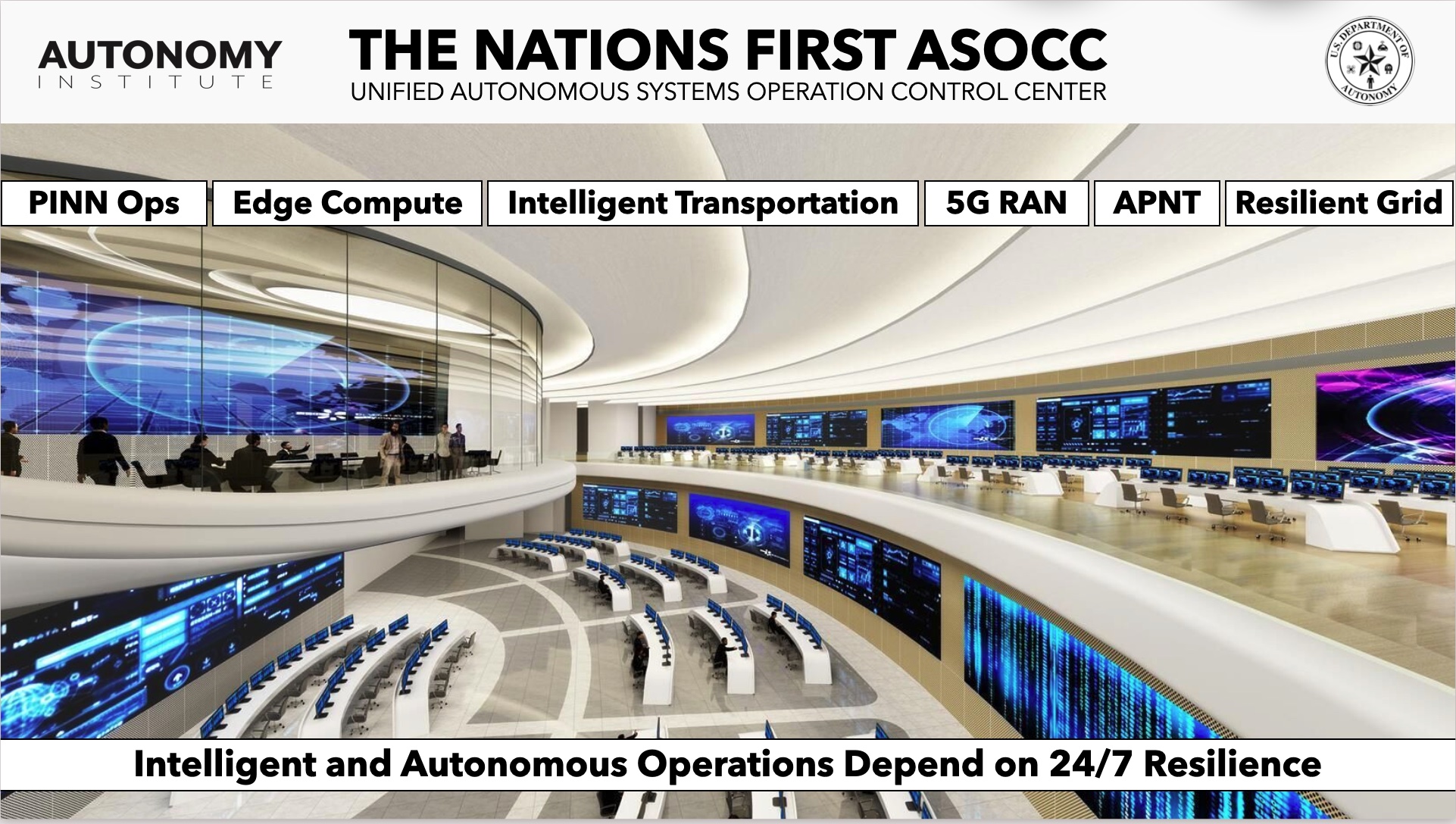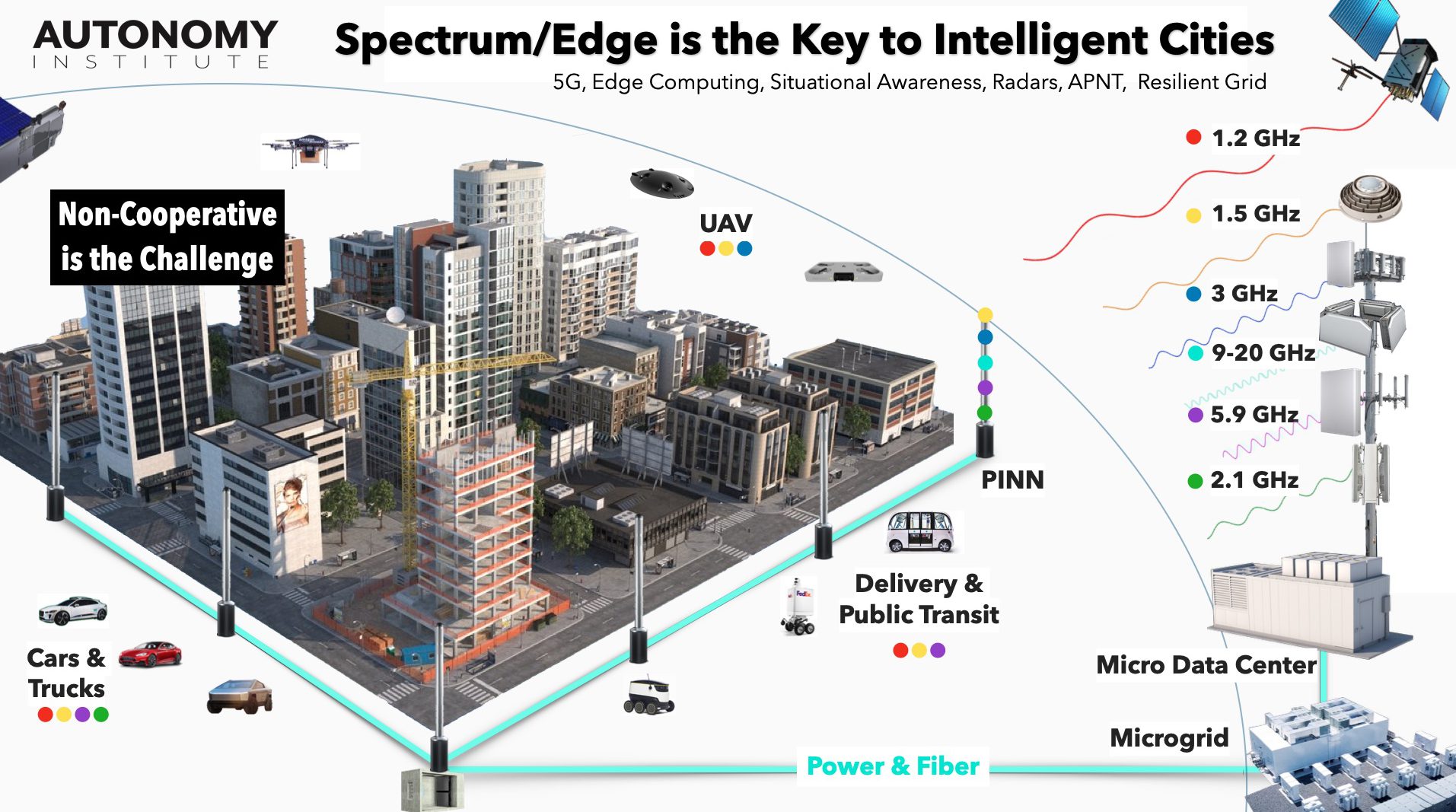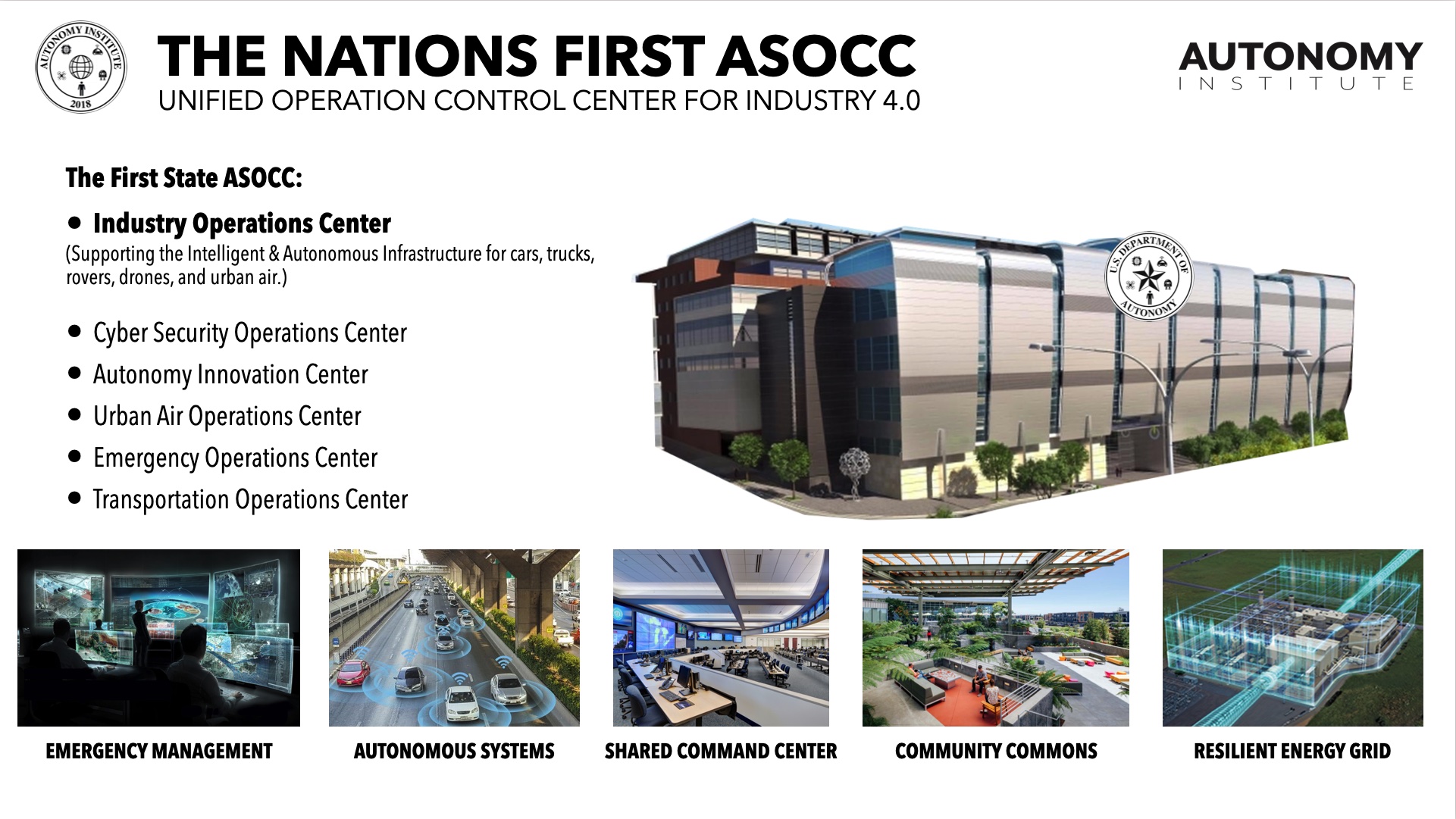Autonomous Systems Operation Control Center
Autonomous Systems Operational Control Centers (ASOCC) will support persistent operations to provide safe, secure, and collaborative public and private deployments of the Intelligent Infrastructure that will enable Industry 4.0 systems. As we embrace more advanced systems within cities and states there has to be a unified Active Digital Twin from the power grid up.
Regional ASOCCs would include:
-
Integrated Transportation
-
Teleoperations
-
Cyber Security Operations
-
Autonomous Systems
-
Emergency Operations
-
Advanced Air Mobility
-
Supply Chain Logistics
-
Electrical Grid Resilience
ASOCCs are being developed as Public-Private Partnerships (P3), very similar to the structure used by the aviation industry with commercial airports. P3s are becoming a key driver for supporting the deployment of intelligent and autonomous infrastructure with cities and states.
These new operational control centers would support a number of public/private organizations like state departments of transportation, emergency management, low-altitude urban air operations, and a growing list of industry partners looking to accelerate a “Path to Commerce” for autonomous systems.

OPERATIONS CENTER TO ACCELERATE COMMERCE
Collaboration can allow lower CAPEX for all providers of operational services. This would also accelerate the “Path to Commerce” by leveraging shared platforms and services. The Active Digital Twin, City Data Exchange, and Intelligent Infrastructure would all provide resilient, safe, and impactful services to each community it serves.

AUTONOMY REQUIRES INTELLIGENT INFRASTRUCTURE
If the United States is going to lead the world with intelligent and autonomous production we need to invest in supporting Intelligent and Autonomous Infrastructure.
Autonomous Systems will never be deployed at scale until we can get edge compute and key technology at the edge. Public Infrastructure Network Nodes (PINNs) will support the rapid deployment of the crucial digital edge hardware. PINNs become supercritical nano data centers, even more, critical than the computers that run our traffic lights and commercial aviation systems. The compute in these units would be extremely high-end since they will be performing the RF and sensor fusion processing at the PINN. This eliminates the major cost of backhaul over fiber and societal issues like privacy and data sovereignty. This would provide an incredible complement to what has already been developed within the autonomous vehicle industry and secure the vital “Non-Cooperative” data stream to advance autonomy forward.

PATH TO COMMERCE FOR INTELLIGENT INFRASTRUCTURE
Autonomy is the next industrial revolution. It requires the bridging of the physical and the digital. The convergence of Edge Computing, 5G, ITS, APNT, and IoT are widely seen as the technologies that build that bridge. Investment in a 21st-century Intelligent & Autonomous Infrastructure is among the highest priorities for stimulating economic expansion, national security, and job growth.
This infrastructure will create Highways and Byways in order to support more efficient mobility, automated city services, autonomous cars and trucks, industrial robotics, autonomous shuttles, air taxis, inspection drones, and many intelligent city applications.
The challenge of digital edge infrastructure is the requirement to be densely deployed on the sidewalk. A unified infrastructure is required to support integrated city services, autonomous systems, commercial use cases beneficial to the community, and National Security and Privacy.
AUTONOMOUS INFRASTRUCTURE GRIDS & CORRIDORS
Autonomous Infrastructure Labs and Autonomous Mobility Corridors will help accelerate the “Path to Commerce” for all types of commercial operations. There is national recognition that autonomy will drive the largest productivity gain in history and will impact just about every industry and certainly every region across the United States. There is a push from the government for collaboration, public-private partnerships, trusted capital, etc. The only way to move the industry forward is by establishing the supporting system-of-systems within a 24/7 operational framework to capture the petabytes of data required.
Over the past few decades the United States technology companies, government, automakers, venture community, research agencies, and universities have spent $100s of billions on autonomous systems. It is now time to transition to active deployments that require operational control within a collaborative environment.
Autonomous Ground-based Delivery Droids and Pods

Autonomous Low-Altitude Delivery Drones

Autonomous Personal and Public Mobility Vehicles

Autonomous Heavy Ground-Based Freight Systems

Autonomous Urban Air Mobility, Advanced Air Mobility Vehicles

Autonomous Inspection and Security Drones

Time to Build and Lead the World
We can continue to slow-roll this industry with proofs-of-concept, pilots, small control centers, teleoperations facilities or we can boldly go where countries like Singapore and China have already. We need to commit to full-scale operational systems design by industry leaders like Gensler, ABB, Siemens, and a long list of other leaders in cooperative centers.
Edge computing, 5G wireless, Intelligent Transportation Systems, and resilient electrical grids will drive the largest infrastructure buildout in our nation’s history. It will drive a massive resurgence of manufacturing, engineering, construction, installation, programming, and jobs of the future.
It is time for the United States to take the lead in the Design, Engineering, Deployment, and Operation of Autonomous Infrastructure and Systems. We have led many transformational industries and it is time for a NEW “ACT” – to lead the world with Autonomy.
1862 Railway Act – Promote the construction of railroads across the United States
1926 Air Commerce Act – Promote and foster Air Commerce.
1956 Interstate Highway Act – Promote the construction of Interstate Highways.
1964 Urban Transportation Act – Promote the construction of Public Transit.
1991 Intermodal Transportation Act – Promote efficient Intermodal transportation.
1996 Internet Commerce Act – Promote competition and rapid deployment of the Internet.
2021 Autonomy Commerce Act – Promote Intelligent and Autonomous Infrastructure
Autonomy is the next industrial revolution. It requires the bridging of the Digital World with the Physical. The convergence of 5G, IoT, edge computing is widely seen as the technologies that build that bridge. To date, no single industry has a business model capable of enabling the large-scale convergence that will launch the next revolution.
It is time for the United States to lead the “Path to Commerce” and establish the National Intelligent Infrastructure Act
The Autonomy Commerce Act will create millions of jobs, deliver broadband across the United States, and generate massive productivity gains within the economy. We need Digital Edge Infrastructure: https://youtu.be/9-w0G7sD8NQ
Visionary leaders like Senator Warner are highlighting the need for a “Digital Edge Commerce Act”.
National Intelligent Infrastructure Act
The Autonomy Institute is developing the team leading the deployment of Intelligent and Autonomous Infrastructure within cities across the US. We are building Autonomous Infrastructure Labs, Corridors, Zones, Regions, Cities, States, and eventually full national deployments.
New Infrastructure has always been the Foundation of Transformations
-
Freight Trains – required Railways and Depots
-
Aviation – required Control Towers, Communications, Radars, GPS
-
Interstate Commerce – required Roads, Highways, Bridges
-
Transport Ships – required Ports and Containers
-
Overnight Delivery – required Nonstop Systems and Air Transport
-
Internet – required Network Access Points, Data Centers, and Fiber


